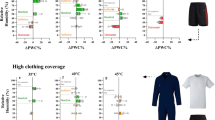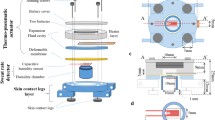Abstract
The paper presents a new method for the evaluation of the physiological limit of heat exposure dependent on the metabolic rate, environmental temperature, humidity and air motion. The method consists of the determination of the conditions of work and exposure that would cause a given rate of sweating which might be considered as the physiologically permissible limit for prolonged exposure, e.g. 1100 g/hr. The expected sweat rate under given conditions of work and thermal environment is given by the formula: S=E (1/f), where S is the expected sweat rate, E is the required evaporative cooling which is equal to the overall heat load, and f is the cooling efficiency of sweating. Formulas and nomograms are presented, which enable quantitative determination of the various components of the formula. Examination of the correlation between the suggested method, and experimental results from several physiological investigations in different countries showed good agreement and linear relationship between the measured and the computed values.
Zusammenfassung
Eine neue Methode zur Bewertung der physiologischen Grenzen der Hitzebelastung unter Berücksichtigung der Stoffwechselrate, der Umgebungstemperatur, Feuchtigkeit und Luftbewegung, wird beschrieben. Die Methode beruht auf der Bestimmung der jenigen Bedingungen bei der Arbeit und Exponierung, die zu einer gegebenen Schweissrate führen und die angesehen werden können als die physiologisch zulÄssige Grenze bei verlÄngerter Exponierung, z.B. 1100 g/hr. Die erwartete Schweissrate bei gegebenen Bedingungen (Arbeit und WÄrme) wird ausgedrückt in der Gleichung: S=E (1/f), darin ist S die erwartete Schweissrate, E die erforderliche VerdunstungskÄlte, die gleich ist mit der gesamten Hitzebelastung und f ist die Abkühlungsleistung beim Schwitzen. Formeln und Nomogramme für die quantitative Bestimmung der verschiedenen Komponenten der Gleichung werden angegeben. Eine Prüfung der Korrelation zwischen der vorgeschlagenen Methode und Ergebnissen von mehreren physiologischen Untersuchungen in verschiedenen LÄndern zeigte eine gute übereinstimmung und lineare Beziehung zwischen den gemessenen und berechneten Werten.
Resume
Ce mémoire présente une nouvelle méthode qui permet d'évaluer la limite physiologique de l'exposition à la chaleur, limite dépendant du métabolisme d'une part, de la température, de l'humidité et du vent d'autre part. Cette méthode consiste à déterminer dans quelles conditions de travail et de chaleur une certaine quantité de sueur est sécrétée. Cette quantité (par exemple 1100 g/hr)peut Être considérée comme la limite admissible, du point de vue physiologique, pour une exposition prolongée. La quantité de sueur probable peut alors Être calculée dans des conditions de travail et d'ambiance thermique données au moyen de la formule: S=E (1/f) où S est la quantité de sueur recherchée, E le refroidissement par évaporation indispensable (il est égal à la charge calorifique totale) et f l'efficacité de refroidissement de la sueur. On donne en outre des équations et des abaques permettant de déterminer quantitativement les divers éléments de cette formule. La corrélation est bonne entre la dite méthode de calcul et les résultats numériques provenant d'essais physiologiques effectués dans divers pays. Les valeurs mesurées et calculées forment entre eux une fonction linéaire.
Similar content being viewed by others
References
GIVONI, B. (1962): Basic study of ventilation problems in housing in hot countries. Research Report to the Ford Foundation, Building Research Station, Israel Institute of Technology, 11–118.
GIVINO, B. (1963): Estimation of the effect of climate on man: Development of a New Thermal Index. Research Report to UNESCO. Building Research Station, Israel Institute of Technology, 1–145.
GIVONI, B. (1964): The influence of work and environmental conditions on the physiological responses and thermal equilibrium of man. Proceedings of UNESCO Symposium on Environmental Physiology and Psychology in Arid Conditions. UNESCO Arid Zone Research, 24: 199–204.
GIVONI, B. and BELDING, H.S. (1962): The cooling efficiency of sweat evaporation. Proceedings, Biometeorology. S.W. Tromp (ed.), Pergamon Press, Oxford, 304–314.
GIVONI, B. and RIM, J. (1962): Effect of the thermal environment and psychological factors upon subjects' responses and performance of mental work. Proceedings First Int. Cong. Ergonomics, Ergonomics, 1: 99–114.
HATCH, T.F. (1958): Heat control in hot industries. In: Industrial Hygiene and Toxicology. F.A. Patty (ed.). Interscience Publishers, N.Y., pp 789–807.
JENNINGS, B.H. and GIVONI, B. (1959): Environmental reactions in the 80‡ to 100‡ zone. Trans. Am. Soc. Heat. Vent. Aircond., 65: 115–136.
MACPHERSON, R.H. (1960): Physiological responses to hot environments. Med. Res. Council sp. Rep. Ser. N. 298 London, HMSO. Contains Summarising works of: Adam J.M., Ellis F.P., Irwin J. O.,Thomson, M.L., Weiner J.S., Jack J.W. John R.T., Jones R.M., Macyheson R.K., Collins J.A.G., Carmichael E.A., Benson R.S., Colver T., Dunham W.F., Holling H.E., Ladell W.S.S., McArdle B., Scott J.W.
McARDLE, B.; DUNHAM, W., HOLLING, H.E., LADELL, W.S.S., SCOTT, J.W., THOMSON, M.L., and WEINER, J.S. (1947a): The prediction of the physiological effects of warm and hot environments. Med. Res. Council R.N.P., 47/391.
McARDEL, B., DUNHAM, W HOLLING, H.E., LADELL, W.S.S., SCOTT, J.W., THOMSON, M.L., and WEINER, J.S. (1947b): The predictions of the physiological effects of warm and hot environments. Med. Res. Council R.N.P., 47/391, H.S. 194/1947, London.
PEPLER, R.D. (1958): Warmth and performance: An investigation in the tropics. Ergonomics, 2: 63–88.
Author information
Authors and Affiliations
Rights and permissions
About this article
Cite this article
Givoni, B. A new method for evaluating industrial heat exposure and maximum permissible work load. Int J Biometeorol 8, 115–124 (1964). https://doi.org/10.1007/BF02187576
Issue Date:
DOI: https://doi.org/10.1007/BF02187576




